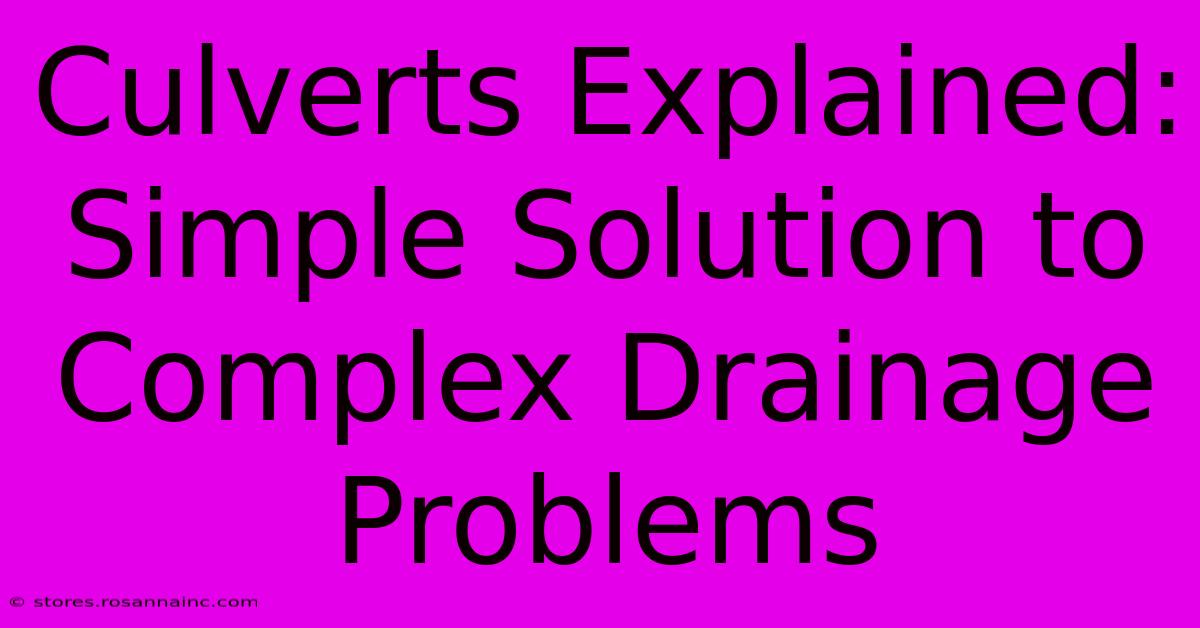Culverts Explained: Simple Solution To Complex Drainage Problems

Table of Contents
Culverts Explained: Simple Solution to Complex Drainage Problems
Dealing with water runoff effectively is crucial for protecting infrastructure, preserving natural habitats, and ensuring public safety. One often-overlooked yet highly effective solution lies in the humble culvert. This article will delve into the world of culverts, explaining their function, types, benefits, and how they provide a simple solution to complex drainage problems.
What is a Culvert?
A culvert is essentially a structure that allows water to flow under a road, railway, trail, or other obstruction. Think of it as a tunnel for water. It's a crucial component of any effective drainage system, preventing waterlogging, erosion, and flooding. Instead of water accumulating and potentially causing damage, culverts safely channel the flow, maintaining the integrity of the surrounding environment and infrastructure.
Understanding the Importance of Proper Drainage
Poor drainage leads to numerous problems:
- Road Damage: Water accumulating beneath roadways can weaken the foundation, leading to potholes, cracking, and ultimately, costly repairs.
- Erosion: Uncontrolled water flow can erode soil, damaging landscapes and potentially causing landslides.
- Flooding: Blocked or inadequate drainage systems can lead to flooding, damaging property and posing safety risks.
- Environmental Damage: Water pollution from runoff can harm ecosystems and wildlife.
Culverts provide a straightforward solution to these issues by efficiently managing water flow.
Types of Culverts
Culverts come in various shapes, sizes, and materials, each suited for different applications and conditions:
1. Material:
- Concrete: Durable, long-lasting, and suitable for high-flow applications.
- Metal (Steel, Aluminum): Lightweight and relatively easy to install, often used in temporary situations or where lighter weight is advantageous.
- Plastic (HDPE, PVC): Cost-effective, lightweight, and resistant to corrosion. Ideal for smaller projects.
- Corrugated Metal: Flexible and adaptable to uneven terrain.
2. Shape:
- Circular: Common and efficient for carrying water.
- Arch: Provides increased strength and capacity.
- Box: Offers greater flow capacity and easier access for inspection and maintenance.
3. Size:
The size of the culvert is determined by factors like the volume of water expected and the slope of the land. Proper sizing is critical to ensure effective drainage.
Benefits of Using Culverts
The advantages of installing culverts are numerous:
- Effective Water Management: Culverts efficiently channel water, preventing accumulation and reducing the risk of flooding and erosion.
- Cost-Effective Solution: While initial installation costs vary, culverts are often a cost-effective solution in the long run by preventing more expensive damage repair.
- Environmental Protection: By preventing water runoff pollution, culverts help preserve ecosystems.
- Improved Infrastructure: They safeguard roads, railways, and other infrastructure from water damage.
- Enhanced Safety: They reduce the risk of accidents caused by flooding or waterlogged roads.
Choosing the Right Culvert for Your Needs
Selecting the appropriate culvert involves careful consideration of several factors:
- Water flow volume: Accurate assessment is crucial to prevent undersizing.
- Soil type: The soil’s stability impacts the culvert's design and foundation.
- Environmental considerations: Minimizing impact on wildlife and vegetation is essential.
- Budget: Weighing costs of various materials and installation processes.
- Maintenance requirements: Some materials require less frequent maintenance than others.
Conclusion: Simple Solution, Big Impact
Culverts represent a simple yet highly effective solution to complex drainage problems. By understanding their function, types, and benefits, you can make informed decisions to protect your infrastructure, environment, and community from the detrimental effects of poor drainage. Choosing the right culvert requires careful planning and consideration of the specific circumstances; however, the long-term benefits significantly outweigh the initial investment.

Thank you for visiting our website wich cover about Culverts Explained: Simple Solution To Complex Drainage Problems. We hope the information provided has been useful to you. Feel free to contact us if you have any questions or need further assistance. See you next time and dont miss to bookmark.
Featured Posts
-
Timothy B Schmit The Eagles Secret Weapon Finally Revealed
Feb 09, 2025
-
Luxury Living Unlocked Your San Pedro Garza Garcia Guide
Feb 09, 2025
-
Connecting With 502 A Guide To Local Resources
Feb 09, 2025
-
Psn Downtime Resolved
Feb 09, 2025
-
The Iron Maiden A Shocking Journey Through History
Feb 09, 2025
